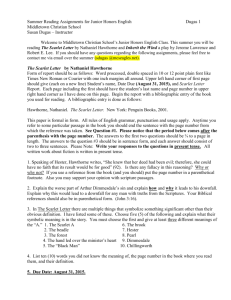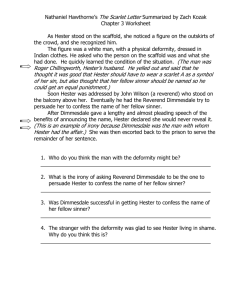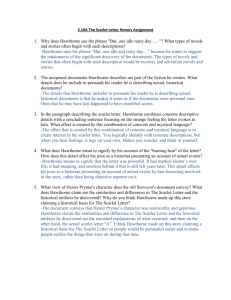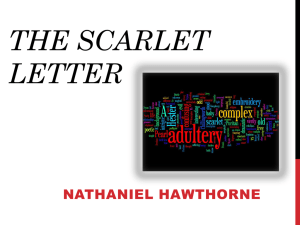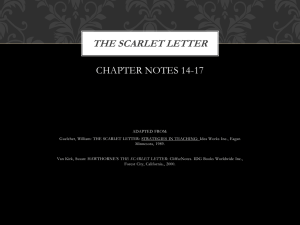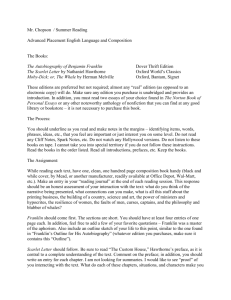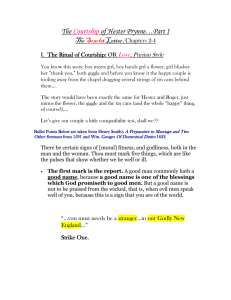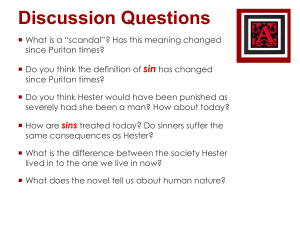Another unhelpful Scarlet Letter essay
advertisement
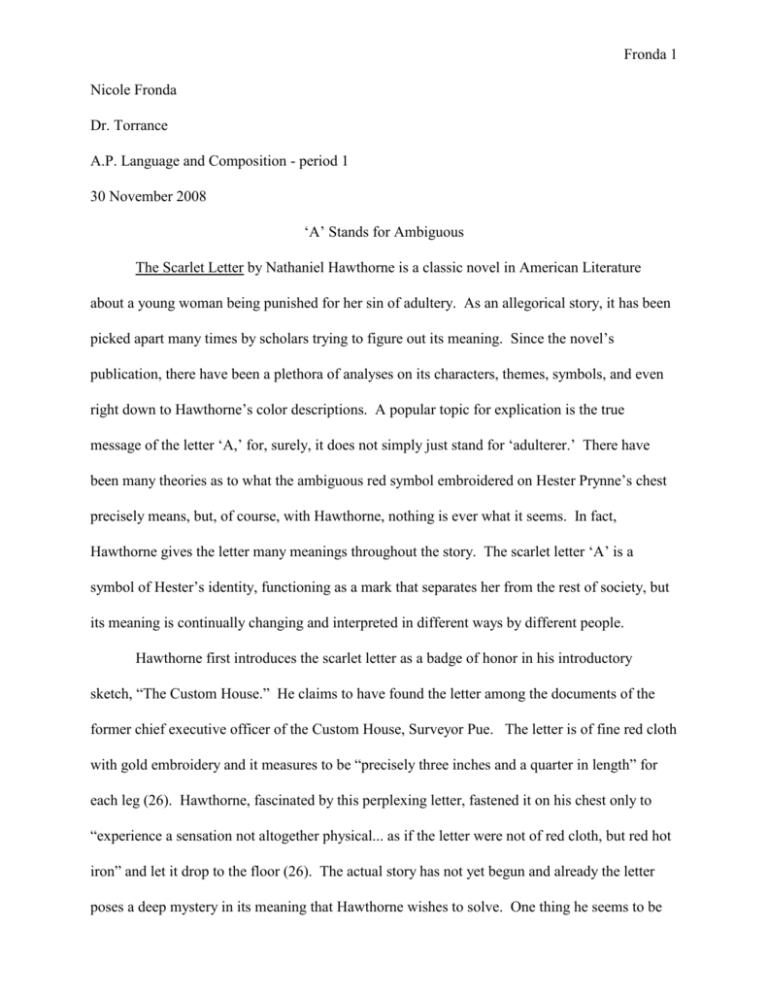
Fronda 1 Nicole Fronda Dr. Torrance A.P. Language and Composition - period 1 30 November 2008 ‘A’ Stands for Ambiguous The Scarlet Letter by Nathaniel Hawthorne is a classic novel in American Literature about a young woman being punished for her sin of adultery. As an allegorical story, it has been picked apart many times by scholars trying to figure out its meaning. Since the novel’s publication, there have been a plethora of analyses on its characters, themes, symbols, and even right down to Hawthorne’s color descriptions. A popular topic for explication is the true message of the letter ‘A,’ for, surely, it does not simply just stand for ‘adulterer.’ There have been many theories as to what the ambiguous red symbol embroidered on Hester Prynne’s chest precisely means, but, of course, with Hawthorne, nothing is ever what it seems. In fact, Hawthorne gives the letter many meanings throughout the story. The scarlet letter ‘A’ is a symbol of Hester’s identity, functioning as a mark that separates her from the rest of society, but its meaning is continually changing and interpreted in different ways by different people. Hawthorne first introduces the scarlet letter as a badge of honor in his introductory sketch, “The Custom House.” He claims to have found the letter among the documents of the former chief executive officer of the Custom House, Surveyor Pue. The letter is of fine red cloth with gold embroidery and it measures to be “precisely three inches and a quarter in length” for each leg (26). Hawthorne, fascinated by this perplexing letter, fastened it on his chest only to “experience a sensation not altogether physical... as if the letter were not of red cloth, but red hot iron” and let it drop to the floor (26). The actual story has not yet begun and already the letter poses a deep mystery in its meaning that Hawthorne wishes to solve. One thing he seems to be sure of, however, is that the woman who once wore this letter, Hester Prynne, was a good, Fronda 2 noteworthy person who “gained from many people the reverence due to an angel” (27). Indeed the description of the letter is as if it were for a holy being: its dimensions are proportionate to the golden ratio, and its colors of red and gold are characteristics of love, loyalty, honor, and heroism. The color red is also a symbol of the presence of God. While the scarlet letter first appears to be a divine symbol, it is later learned that the letter is a mark of a sinner, and, unlike a badge of courage, it is, as Hawthorne said when he tried on the letter, like a permanent brand of a red hot iron. Hester Prynne committed the sin of Adultery and, as proof of this crime, she, in the words of Frederick Newberry, “had the letter A branded upon her,” an act that has her completely and permanently isolated from the rest of society (Newberry 332,2). In his essay, “A Red-Hot A and a Lusting Divine: Sources for The Scarlet Letter, Newberry claims that Hawthorne may have taken the idea of the scarlet letter from certain recorded cases of adultery from Puritan times in Massachusetts. Such cases are similar to that of Mary Batcheller, who had been sentenced to “receave 40 stroakes save one... & be branded with the letter A” after committing the sin of adultery with George Rogers (Newberry 322,2). This evidence proves that the scarlet letter was not Hawthorne’s idea, but one that the Puritans invented, thinking that it was a good and immutable way to mark a sinner. The color red, after all, stands for sin, sex, guilt, and can be associated with prostitutes. And, just as red could indicate the presence of God, it also is a symbol of the Devil, or, as his messenger is called in Puritan culture, the Black Man. That is why Pearl believed her mother’s scarlet letter was “the Black Man’s mark on thee” (120). The scarlet letter for Hester Prynne identified her as a sinner. Hester’s letter later on, however, acquires an entirely different interpretation than that of a devilish one. Once, when she had first been branded by the letter, Hester was an outcast. The red hue of the letter served as a warning and no one dared to approach her. They called her a hussy, claimed that she was a shame to their community, and that she has no virtues. They did not even allow her embroidery to be used at weddings and bridal gowns. She was lonely and Fronda 3 “without a friend on earth who dared to show himself” (57). Now, instead of meaning adulterer, abomination, amoral, or abandoned, the people “refuse to interpret the scarlet A by its original significance” and claim “that it means Able” (106). And not only does it mean Able, but, through Hester’s kindness, generosity, love, and benevolence, the A also means Admirable, Amiable, Apostle, and, as it was first interpreted, Angel. Her “blameless purity” is reflected in this scarlet symbol of love, courage, sacrifice, and divinity (106). However, despite the now positive feelings from the people of the town, Hester still is, in a way, abandoned and set apart from the rest of society. While Hester is the only person in the town who wears the scarlet letter, there is another person, one with whom she had committed adultery, who silently bears the same shame. Reverend Arthur Dimmesdale is a man admired by all the people in the Puritan community, many of whom say that he is too holy for this world. However, Dimmesdale is plagued with guilt and shame for his sin. As Millicent Bell states in “The Obliquity of Sings: The Scarlet Letter,” “Society has placed no token upon him,” and the people continue to respect and adore him when he too, as he knows very well, should be shunned and made to wear the letter like Hester (Bell, 457, 7). His guilt and leads to a deterioration of his physical and spiritual condition and creates a great pain in his bosom. In an attempt to alleviate this pain, Dimmesdale often keeps his hand over his heart, where his own scarlet letter “burns in secret” (124). It is a burning pain that is, no doubt, similar to the sensation of a burning iron that Hawthorne felt when he tried the letter on himself. One night, in his silent suffering, Dimmesdale stands on the platform of the scaffold where Hester once stood as punishment for her crime. He calls to Hester and Pearl to stand with him on the scaffold, and together they witness “ a blazing spear” of a meteor which illuminated an immense, red letter A (102). To Dimmesdale, this god-sent, celestial version of Hester’s scarlet letter is an implication that he should wear the letter on the outside as she does, rather Fronda 4 than within his own bosom. To the townspeople, however, the letter A is believed “to stand for Angel” (104). This difference in interpretation of the letter shows that it does not have a fixed purpose. Its ambiguity allows it to be a true, meaningful, and perfect symbol for anyone who sees it, whether they understand it as good or bad. From Angel to Adulterer, to Able to Angel again, the letter’s meaning is constantly changing. Its initial implication of Adultery, as the Puritan society had intended, was not permanent after all. And, physically, the piece of cloth that gives this symbol shape is not permanent either. It can be easily taken off, but Hester continues to wear the scarlet letter, even when she had the chance to be rid of it by revealing her lover, and even when it was offered by Chillingworth to have her removed of it. Perhaps, as Sacvan Bercovitch suggests in “The APolitics of Ambiguity in The Scarlet Letter,” Hester continues to wear the letter “for love alone,” the letter A for Arthur Dimmesdale (Bercovitch, 4). After all, she does not reveal Dimmesdale as Pearl’s father, therefore choosing to sacrifice her freedom for him by claiming that it is “too deeply branded” (49). Hester herself also says later that “were [she] worthy to be quit of it, it would fall away of its own nature” or turn into something with a different meaning (110). Thus, Hester wears the scarlet letter out of love and guilt, and she continues to remove herself from the community in repentance, knowing full well that she committed a sin and that she is deserving of this burning shame. However, after seven years with this burning shame, Hester finally takes off the scarlet letter “in a gesture of defiance” only to place it back on to please her daughter (Berkovitch, 582, 7). Hester and Dimmesdale’s meeting in the forest leads them to a decision to leave Boston together with Pearl. Hester wanted to remove the letter knowing that she will now live a better life with the ones she loves, undoing her past mistakes. However, as described by Bercovitch, Pearl keeps her from “disavowing the office of the A” ( Bercovitch 582, 7). Now, like Pearl, the letter truly has become a permanent part of Hester’s life, for after this, Hester never again Fronda 5 removes it. In consequence of Dimmesdale’s death on the scaffold, she continues to wear it out of love and shame of her sin. Dimmesdale’s punishment for his sin was death, and although he repented before his end, his reluctance to wear the scarlet letter and outwardly bear the same shame as Hester produced his own red scarlet letter, burned and branded on his chest. Hester’s punishment was to wear the scarlet letter for the rest of her life and forever be recognized as a sinner. However, Hester has fully repented for her sin through her time on the scaffold, her relinquishment of freedom, and through her many good deeds to the people of the community. Hester is indeed an Angel. Her scarlet letter that was once a grotesque mark of a sinner, becomes a royal badge of courage, described, on her gravestone, like a noble coat or arms, “On a Filed, Sable, The Letter A, Gules” (166). The scarlet letter is, indeed, a special, mystical symbol with many mysteries behind it. Like a permanent brand of a red hot iron, the scarlet letter was permanent mark for Hester Prynne. However, its meaning was always being altered. Society’s feeble attempts to constrain Hester and give her a fixed label of a sinner did not hide Hester’s good nature. While the letter initially has an evil meaning, Hawthorne always seems to describe it as having qualities of the divine. But for whatever reason she wears it, or however it is interpreted, whether it stands for Adulterer or Angel, the scarlet letter reflects of Hester Prynne’s identity.


